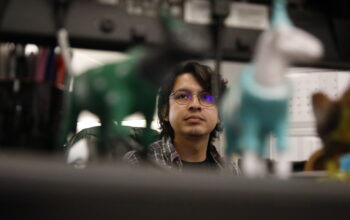Armed with creativity and a holistic approach, professor Michelle Meyer tries to make an intimidating subject relatable to students.
Meyer has taught at Pierce College since spring 2003, and she uses a holistic style of teaching to help students learn physics. The goal of holistic education is for students to be able to make connections between what they’re learning and real world applications.
“What’s important is for students to make connections with physics and nature,” Meyer said. “You have to teach fundamentals, but it doesn’t have to be boring. There should be some major connections.”
The holistic method is aimed at tapping into the many different ways that individual students learn, which is a lot different than the usual one size fits all curriculum. As part of her holistic teaching style, Meyer does not give midterms. Instead, she gives students weekly quizzes.
“I give weekly quizzes, because I do not believe in midterms,” Meyer said. “Weekly quizzes keep students on a learning pattern, rather than them knowing the fourth week into school they’re going to have a midterm, and it turns into cramming, and they lose that fundamental step of learning bit by bit.”
She tailors her classes to maximize retention of what was learned.
“My approach is not to give them technically super hard physics problems, because they’re not going to gain anything from it,” Meyer said. “If I have to take a day of class to reinforce ideas I will do that.
Through use of the senses, she is able to help students make connections between concepts and applications.
“I use language, animation, and tactile things,” Meyer said. “I’ll bring things in for students to handle, so that they can then embed themselves into it with touching, and being able to move it around.”
Meyer also uses mnemonics to help students remember things.
“I like to use fun mnemonics so that students will have something silly to remember, but they’re now making a visual connection too,” Meyer said. “For example, we’re learning certain concepts and we say we pray to this particular law.”
According to Dale Fields, chair of physics and planetary sciences, his department is one of the most diverse on campus. He said that the physics department tries to tailor its teachings to the students through research of what techniques work well.
“The physics department focuses on physics education research so that they can find what techniques are the most useful at teaching students how to learn physics,” Fields said.
Dr. Margaret Wessling, physics professor, said that some physicists have focused their research on how people learn physics.
“One of their overwhelming findings was that people don’t learn very much from lectures,” Wessling said. “People don’t really retain it unless they’re doing something active themselves.”
Meyer understands and remembers what it’s like to be in her students’ shoes.
“I relate to my students because I know their struggles. I struggled with taking physics as an undergrad pre-med major,” Meyer said. “I have a bachelors in molecular biology and my masters in physics, so I have a greater sensitivity to the non-engineering students.”
Two of her classes were cancelled this semester, Physics 66 and 67, due to lack of enrollment.
“I’m not happy they cancelled my classes,” Meyer said. “I had 14 students enrolled, and two who were going to add the first day of class, but our campus is looking to have maximum fill capacity for each class, and 15 students is the minimum.”
“To change the philosophy to a more business approach, which is to fill those classes up and be cutthroat with it, is not in the students’ interest and it’s a major disservice and disruption,” Meyer said.
She also stated that students take her physics classes because they have to, not because they want to.
Being women in physics has its hardships according to both Meyer and Wessling.
“It’s definitely something that you notice,” Wessling said. “There is still a big gender imbalance, for instance, in my Physics 101 class, only 11 out of 39 students are women, and that’s actually a pretty high ratio.”
“It’s a problem because female students look around and see a lot of guys and think that they don’t belong there, and I’d like to see that change,” Wessling said.
Meyer dealt with the adversities of being a woman when she worked in the engineering industry.
“There are still issues with men dealing with women, especially if women don’t act in a subordinate role,” Meyer said. “Women who have their own opinions and are proactive throw off a lot of men.”
Although Meyer has worked in both the aerospace and commercial engineering industries, she finds teaching to be the most gratifying.
“I like to see the light bulb that turns on when students get over the trepidation that physics has to be super technical,” Meyer said. “I prefer teaching to working in the industry, because students actually say thank you,” Meyer said.



